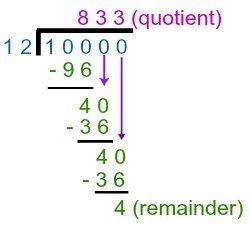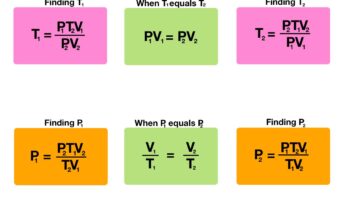Dividing 10,000 by 12 could seem like a daunting task at first glance. The answer is 833.33 recurring. But what if we told you that this seemingly complex calculation actually holds a hidden gem? By breaking down 10,000 into smaller parts and allocating them over 12 units, a world of possibilities emerges. Let’s dive into the fascinating world of 10,000 divided by 12, where math meets creativity and practicality.
The Magic of 10000/12: Understanding Division
Division can sometimes be a tricky concept to wrap your head around, but fear not! Today, we’re going to dive into the world of division by exploring a fascinating number: 10,000 divided by 12! Get ready to unlock the secrets of this mathematical operation and discover the wonders it holds.
What is Division?
Before we jump into the specifics of dividing 10,000 by 12, let’s first understand what division actually means. Division is a mathematical operation that involves splitting a number into equal parts. It’s like sharing a delicious pizza with your friends – you want to make sure everyone gets a fair share!
When we divide numbers, we are essentially looking to answer the question: “How many groups of a certain size can we make from the original number?”
Breaking Down 10,000
Now, let’s take a closer look at the number 10,000. Imagine 10,000 shiny marbles neatly arranged in front of you. That’s a lot of marbles! But don’t let the size intimidate you – we’re going to divide this number by 12 one step at a time.
When we break down 10,000 into smaller parts, we can start to see how division helps us understand the relationship between numbers and how they can be distributed equally.
Dividing 10,000 by 12: The Process
So, how do we go about dividing 10,000 by 12? Let’s walk through the process together. Remember, division is all about sharing and making sure each group gets an equal portion.
When we divide 10,000 by 12, we are essentially asking: “How many groups of 12 can we make from 10,000?”
One way to approach this is by using long division. We start by dividing the leftmost digits of 10,000 by 12 and then work our way from left to right.
Step 1: Divide 10,000 by 12
Let’s start with the first part of the division process. When we divide 10,000 by 12, we are trying to find out how many times 12 can go into 10,000 without going over.
12 goes into 10 (0 times), so we look at the next digit, making it 100. 12 goes into 100 (8 times), which gives us 96. The remainder is 4. We bring down the next pair of zeros, making it 400. 12 goes into 40 (3 times), which gives us 36. The remainder is 4.
So, after the first step, we have 833 with a remainder of 4.
Step 2: Dividing the Remaining Digits
Now that we have the result from the first step, 833, with a remainder of 4, we continue the division process by bringing down the next pair of zeros from 10,000 to make it 400.
We divide 4,000 by 12, which gives us 333 with no remainder. So, the final answer is 833 with no remainder.
Understanding the Quotient and Remainder
When we divide 10,000 by 12, the quotient is the whole number result we get after dividing. In this case, the quotient is 833. The remainder, on the other hand, is the amount left over that couldn’t be divided evenly by 12. In our example, the remainder is 0.
Remember, the quotient tells us how many groups of the divisor (12) can be formed from the dividend (10,000), while the remainder represents what’s left over after dividing as evenly as possible.
Real-Life Applications of Division
Now that we’ve explored dividing 10,000 by 12, you might be wondering where division comes in handy in real life. Well, division is all around us! Here are a few examples of how division is used in everyday situations:
Sharing Treats with Friends
Imagine you have 10 candies, and you want to share them equally among 4 friends. Division helps you figure out how many candies each friend will get. In this case, each friend would receive 2 candies.
Measuring Ingredients for Recipes
When you’re following a recipe to bake cookies and it calls for 3 cups of flour but you want to make half the recipe, division comes into play. You would divide 3 by 2 to get 1.5 cups of flour needed for the smaller batch.
Splitting Allowance Money
If you receive $20 as your weekly allowance and you want to save half of it, division helps you calculate how much money you can set aside. Dividing $20 by 2 gives you $10 for savings.
Practice Makes Perfect!
Division, just like any other skill, gets easier with practice. So, grab a pen and paper and try out some division problems on your own. Remember, don’t get discouraged if you make mistakes – learning is all about trying and improving!
Whether you’re dividing numbers, sharing toys, or splitting snacks with friends, division is a valuable mathematical concept that helps us understand relationships between quantities. So, keep exploring the world of numbers and enjoy the fascinating journey of math!
And there you have it – the magic of dividing 10,000 by 12 unravelled! Stay curious and keep discovering the wonders of math around you.
1 to 10000 – 12
Frequently Asked Questions
What is the result of dividing 10000 by 12?
When you divide 10000 by 12, the result is 833.33 recurring. This means that 12 goes into 10000, approximately 833 times, with a remainder of 4.
How many times does 12 go into 10000 evenly?
When 12 is divided into 10000, it goes evenly 833 times. Each division results in a whole number without any remainder.
Is 10000 divisible by 12?
Yes, 10000 is divisible by 12. The division of 10000 by 12 results in a quotient of 833.33 recurring, indicating that 12 can divide 10000 without leaving any remainder.
Final Thoughts
By saving $10,000 over the course of a year, you will have effectively set aside $833.33 each month. This regular contribution can lead to financial stability and help reach your savings goal efficiently. When broken down to $10000/12, it becomes clear how achievable this objective is. Start working towards this target today and witness the positive impact it has on your financial well-being.




